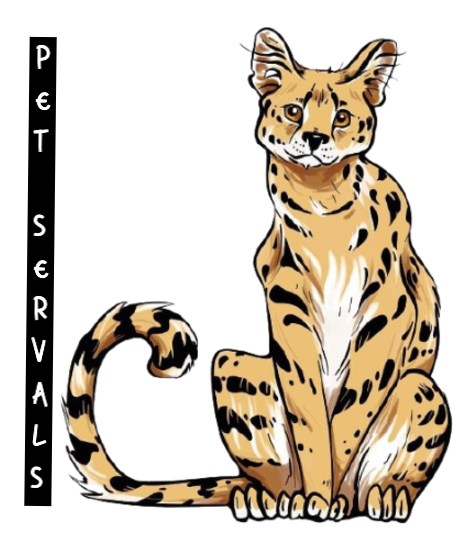SERVAL DIET
Servals are obliged to being carnivores meaning their diet consists mainly of meat protein. They are sensitive to taste, texture, smell and the taste of food. Servals prefer warm over cold in that they prefer food that is close to body temperature (101 Fahrenheit) as they consume live prey starting with the head. Most cats prefer variety in their diet over a constant meal and the opposite is true when they are stressed. They have small stomachs so; they are compelled to eating smaller amounts of food than omnivores and herbivores and they cannot digest complex starches and fibres like vegetables and fruits because they have a shorter intestinal length.
Servals possess sharp and carved retractable claws which enable them to catch and secure their prey, scissor-like teeth that enable them to bite their prey into its spinal cord, they also have whiskers that enable them to hunt in dim light. Serval cats are nocturnal animals and sometimes diurnal when they are in the wild, they are also terrestrial, and can swim and climb. Servals are known to hunt large prey than themselves as they hunt around marshy places, rivers, grasslands, forests, and bushed countryside. Servals enjoy each other's company, when there is enough food in the wild but mostly, they hunt alone. They explore small holes in search of their prey. Their diets vary according to season and habitat, wild Servals feed on small terrestrial animals but they usually feed on fur, innards and bones (try looking for feeder rats supplier and also rats, rabbits, guinea pigs and chicks, you can also search on my Facebook group "F1 Savannah cats" how others take care of their Servals.
20% of a serval's diet in the wild consists of any combination of birds, reptiles i.e., frogs and lizards whereas the remaining 80% consists of rodents; mice, rats and rabbits. However, a domestic Serval feeds on grass, whole raw chicken, whole raw turkey, raw venison, raw beef, raw squirrel, raw quail, and raw fresh fish. Make sure to thaw any frozen meat before feeding you Serval because when the meat is frozen the bones are brittle and splinter, avoid thawing in the microwave (Do not feed them cooked meat or poultry, it hazardous to the Servals). I highly recommend that you do not use supplement to feed Servals unless the vet recognises some kind of deficiency and do not give them cat food instead feed your Servals with good quality commercial wet food together with whole prey.
Be careful to over supplement your servals, make sure to use the "third diet balance" because if you over supplement, the man-made nutrients seizure by building up in the liver and kidneys and this can lead to death. Serval kittens may be too small to chew bone but do not use supplementary foods instead, you can grind their bone until they are strong enough to chew bone. You can join the Facebook group where people share their recipes, suggestions and advices, you can also order food from the reputable companies that supply Serval diets. All recipes must contain 10% bone and cartilage. 10% organs and 80% lean meat. Make sure to use a high-quality grinder when grinding food, (I prefer the Gander Mountain #12, it is an electric Meat grinder, it comes with 3 blades and has no plastic parts. The cheapest way is to grind your own food, grind thoroughly, spread the ingredients evenly and feed with wet food to ensure they get all the soluble supplements they require and whole prey.
The recipe must be kept frozen and thawed when needed, packed into sandwich sized plastic snap containers and they usually last for two weeks if it's one Serval cat. When the Serval reaches 12 to 16 weeks stop feeding them with prey instead feed with whole prey and quail wet food. They usually eat 4 to 5 meals a day but as they grow older, they start reducing to 3 times but maintain the feeding timetable at all times to keep your Servals happy. Servals like variety in their diet, you can feed them with high quality cat food in the morning, mice lunch and grind at night. Mix grind with cat food or place the mice in the grind for a little change but when they get older, add whole prey i.e., guinea pigs, fish, chicken and rabbits.
